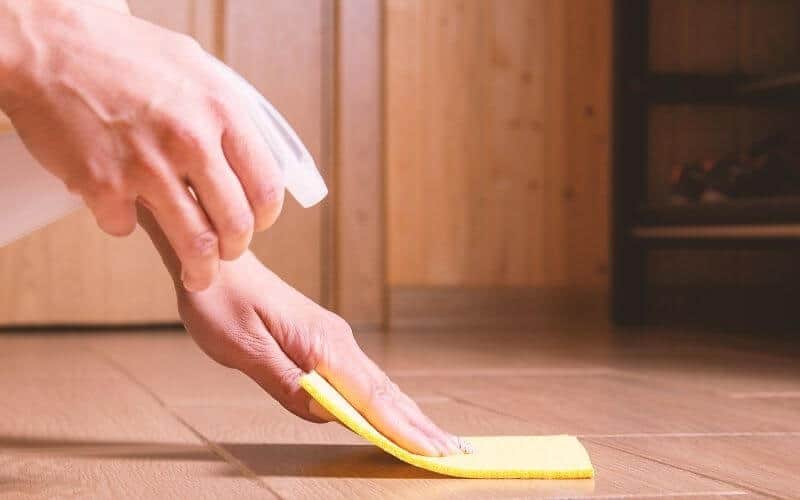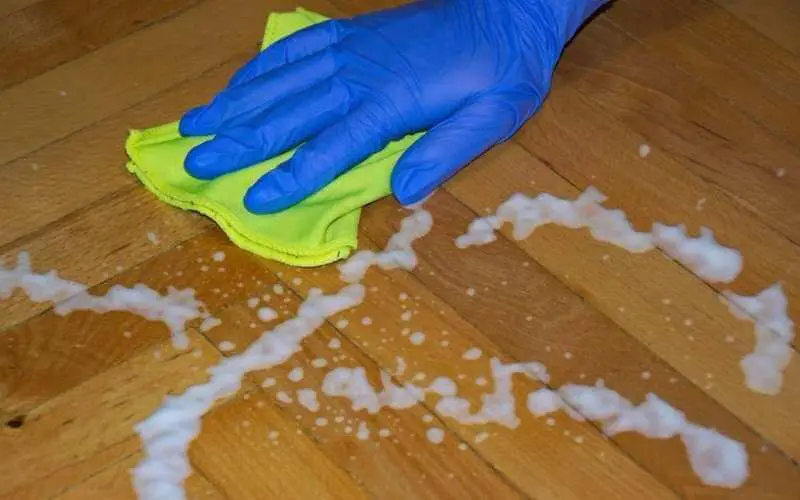Nothing thrives the habitation of fleas than a humid, dark, and warm area that contains plenty of food, an example of such an area is underneath floorings, so can fleas live on hardwood floors? yes! Fleas can live on hardwood floors.
Fleas can develop between the joint of two boards as flea larvae are adapted to avoid light, so they bury down into deep crevices, especially when your hardwood floor has been exposed to moisture for too long.
To remove flea from wooden floors, you would need to apply an insecticide after thorough sanitation has been done to remove any fleas and their larva alongside other organic debris.
How to Remove Flea From Wooden Floors
Table of Contents
Block the Gaps and Cracks
Start by blocking any gaps and cracks present on the hardwood flooring that serves as a hiding place for fleas and bugs.
Fleas flourish in hidden places and cannot survive on an exposed floor surface. Seal those gaps, and this traps the fleas, causing them to starve to death.
You can do this by applying putty, caulk, or wood filler, which also helps restore the floor to its original look. When the gaps and cracks on the floor are sealed, it forces the fleas to find alternative habitats, thereby reducing the infestation significantly.
Dawn Dish Soap
Another way to remove flea from wooden floors is by using dawn dish soap, which is toxic to fleas, and eliminates them by drowning.
However, you have to use dawn dish soap in small quantities as it can damage your flooring if applied in large amounts. Using too much dawn dish soap, which is a detergent, on a wooden surface can ruin its quality finishing.
Before you begin the process of killing fleas on hardwood floor, sweep the area thoroughly to get rid of debris and dirt particles.
Next, dilute the detergent since just a small quantity is needed, pour 5 liters of warm water 85°f-100°f into a bucket, and add 10 ounces of dawn dish soap.
Soak a soft hand towel in the solution, and wring out excess water before using it to wipe the infested areas. Make sure to get the solution get into every gap and crack on the floor where the fleas could be hiding.
White Vinegar
White vinegar is another solution that could be used to remove fleas from wooden floors. However, there is a downside to using pure vinegar on wooden floors as it can remove the glossy sheen finish.
To curtail potential damage, you would need to dilute the vinegar, do this by combining equal parts of white vinegar and water and apply the solution to the infested areas. Let it sit on the floor surface until it dries up; you do not need to wipe it out.
Diluting your vinegar before use is very important as it is acidic in its concentrated form and can damage your hardwood floors.
The damage may not happen instantly after use but occurs gradually with time. This means that repeated uses of pure vinegar could result in your hardwood floor looking faded, old, and worn out. Occasionally spritzing white vinegar over your wooden floors can also keep flea infestation at bay.
Read: How to clean wood floors with vinegar
Boric Acid
Another friendly approach to removing flea from wooden floors is boric acid. It is safe to use on wooden floors and very easy to use with a handful of different purposes.
When boric acid is used on wooden floors, it doesn’t leave behind stubborn stains or weaken the wood’s structure. Boric acid possesses hygroscopic properties, which helps to absorb water from the water-damaged parts of the wood, which prevents rot.
Sprinkle a generous amount of the boric acid powder on your wooden floor, and allow it to sit for 1 to 2 days. Ensure to cover the entire floor as well as crevices and dark corners.
If there’s any furniture or upholstery around the infested area, spray some product over them as well as inside wall cracks to eliminate fleas that could be hiding there.
The fleas ingest boric acid, which has devastating effects on their stomachs and nervous system. They contain jagged particles that also tear up the insect’s exoskeleton and wreak its inside, soaking up all the moisture in the flea, totally dehydrating it.
However, you would need to apply proper precautions when handling boric acid or borax as it can be hazardous to your household. Inhaling or ingesting a substantial amount of the product can pose serious health issues for both pets and humans.
Read: Does steam cleaning kill flea
Precor 2000
Precor 2000 is a liquid prevention spray that can also be used to treat fleas surfaces. It is a commercial product that can be used on many floor surfaces in its liquid form.
This product isn’t a pesticide but an insect growth regulator. It is more effective in eliminating developing fleas rather than mature ones.
Precor 2000 works by preventing the flea’s eggs and larvae from maturing into adults; this greatly affects the fleas infestation and steadily reduces their population until they are completely eliminated with continuous usage.
You simply need to spray the product all over your house and allow it to dry; the area being treated should be closed off until the place is completely dried.
Vacuuming before spraying Precor 2000 helps to achieve a better result by helping you eliminate more fleas. You would need to repeat treatment every 14 days until you completely eradicate all the flea eggs and larvae in the area.
Diatomaceous Earth
The final product on this list that you can use to treat fleas infestation on wooden floor is diatomaceous earth. It is a food-grade dry treatment; diatomaceous earth is a powdery substance made from the sediments, fossils of diatoms that lived millions of years ago.
Diatomaceous earth is very effective in preventing fleas infestation as well as many other insects; it is hygroscopic like boric acid.
When consumed by the insect, it punctures its waxy exoskeletons and absorbs all their moisture. Diatomaceous earth is quite safer and less toxic, and this makes it more suitable for homes with kids and pets.
The product can be applied the same way you would with boric acid. Sprinkle a generous amount over the infested area, completely covering all the nooks and crannies.
Related: 10 Best flea powder
Does Salt Kill Fleas on Hardwood Floors
Yes, salt can kill fleas on hardwood floors. It is a natural and safe way to efficiently control fleas’ infestation. However, it may not be the fastest method as the salt does not kill the fleas on contact.
It has to drain them for a while, and they have to be covered in it. Simply identify the infested areas and sprinkle a generous amount of salt over the area.
You can mix in some baking soda with the salt for increased efficiency. Mix the two in equal proportions and sprinkle on the wooden floors to kill the fleas.
Sprinkle the mixture over the infected area and let it settle for 1-2 days. It is an efficient but slow measure, so you would need a repeated application in order to achieve an effective resolution. If you desire instant results, you would have to opt for other alternatives listed above.
Read: How to get rid of flea on laminate floors
Can Fleas live on hardwood floors? Final Thoughts
If you are searching up this question, chances are, you probably have a flea infestation in your home. Fleas can, in fact, live on hardwood floors; they thrive abundantly in the cracks and gaps between hardwood floors.
This article discusses how to remove flea from wooden floors; most of the products needed are household products you can readily find in your pantry, like vinegar, dawn dish soap, and even salt. You can also opt for products like Precor 2000, diatomaceous earth, and boric acid.

